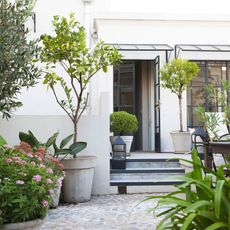History Of Crème Brulee Tomatoes

You love crème brulee, you've gotta love Crème Brulee tomato plants, right? Wrong! The jury is out about this heirloom variety: some gardeners find the taste an intriguing sweet/savory mix, others are disappointed in its mushy consistency and unusual flavor. You'll have to try it yourself since the gardener's vote counts most.
History of Crème Brulee Tomatoes
Given crème brulee's French heritage, you might assume that the history of Crème Brulee tomatoes would begin in La France, but it ain't so, Joe. These heirloom tomatoes come from Russia and were brought into the country by Baker Creek Heirloom Seeds. Their scientific name is Lycopersicon lycopersicum. If you aren't sure what the term "heirloom" means when applied to veggies, you're not alone. Heirloom started off as a description of a vegetable or plant variety with such excellent characteristics that it was passed down through several generations of a family. All heirloom plants are open pollinated and genetically unique, with an evolved resistance to pests and diseases that other types of vegetables lack. Unfortunately, some commercial vendors have played fast and loose with the term "heirloom." You may see it used commercially to mean open-pollinated varieties introduced before 1940, or tomato varieties more than 50 years in circulation.
Growing Heirloom Tomatoes
Almost everyone agrees that Crème Brulee heritage tomatoes are attractive. The ripe tomatoes are perfectly round and about the size of a baseball. They are a darkish red color, sometimes caramel colored or rusty red with hints of chocolate or deep green. These tomatoes take an average amount of time to ripen, and you'll be able to taste them sometime around 69 to 80 days. The taste is trickier to describe. These heirlooms are sweet, but also have a savory flavor. Some find it less sweet than expected, more like melon sweet than dessert sweet, and the name probably comes from the caramel color, not the taste. It is an interesting and complex flavor and a beautiful fruit - clearly a tomato variety worth trying.
Gardening tips, videos, info and more delivered right to your inbox!
Sign up for the Gardening Know How newsletter today and receive a free copy of our e-book "How to Grow Delicious Tomatoes".

Teo Spengler is a master gardener and a docent at the San Francisco Botanical Garden, where she hosts public tours. She has studied horticulture and written about nature, trees, plants, and gardening for more than two decades. Her extended family includes some 30 houseplants and hundreds of outdoor plants, including 250 trees, which are her main passion. Spengler currently splits her life between San Francisco and the French Basque Country, though she was raised in Alaska, giving her experience of gardening in a range of climates.
-
 Never Use Homemade Compost Until It Passes This Simple Radish Test
Never Use Homemade Compost Until It Passes This Simple Radish TestThe radish test is a foolproof trick for knowing whether your homemade compost is ready for planting – or if it could harm the health of your plants.
By Mary Ellen Ellis
-
 Best Trees For Containers: Create A Potted Grove On Your Porch With These 8 Compact Varieties
Best Trees For Containers: Create A Potted Grove On Your Porch With These 8 Compact VarietiesWe may not always think of trees as being obvious candidates for pots, but there are a few that not only thrive but flourish. Here are some of the best trees for containers
By Teo Spengler